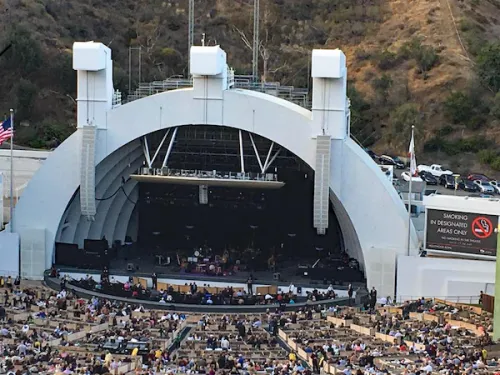The Beatles’ Hollywood Bowl show sold out in just 3.5 hours – proof of LA’s famous music venues’ incredible draw. The city’s legendary stages have shaped music history over the last several years since 1957. The Troubadour hosted Elton John while the Whisky a Go Go launched The Doors to stardom.
LA’s vibrant music scene reaches way beyond the reach and influence of these iconic moments. The city’s musical landscape spans from the historic Shrine Auditorium to underground gems like The Smell. Each venue carries its own compelling story. The Roxy Theater’s stage has felt the footsteps of legends like Neil Young and Prince. Meanwhile, the Viper Room came alive with electrifying shows by Iggy Pop and The Strokes. These remarkable venues range from massive arenas holding 17,000 screaming fans to intimate spaces where 500 people share unforgettable musical moments. Together, they’ve created the soundtrack that defines generations.
The Birth of LA’s Music Scene
Sunset Boulevard’s musical journey started in the early 1920s when La Boheme, the Strip’s first nightclub, served illegal hooch during Prohibition. This simple cattle trail grew into a 22-mile stretch of melodic history.
Early concert halls and theaters
Dorothy Chandler altered LA’s cultural map in the mid-1950s. Her tireless fundraising brought in $19 million (worth $146 million today) for the Music Center project. The Los Angeles Theater opened its doors in 1931, built in just six months with Charlie Chaplin’s money backing the project.
The Music Center became LA’s turning point. The project brought together the wealthy families of Pasadena and San Marino with Downtown LA’s businesses and West LA’s liberal entertainment industry.
Rise of the Sunset Strip
The Strip saw a decline in the late 1950s, but experimental jazz clubs and coffeehouses soon filled the void. The Crescendo opened in 1954 and became the life-blood venue for progressive performers like Nina Simone, Art Tatum, and comedians Bob Newhart and Redd Foxx.
A new identity emerged on the Strip in the early 1960s. The Whisky a Go Go, LA’s first discotheque, made its home in an old Bank of America building at 8901 Sunset. Stars like Steve McQueen, Cary Grant, and The Beatles members frequented the venue.
Ciro’s became Ciro’s Le Disk in 1964, adding to the musical landscape. The Byrds started their famous residency there in March 1965, where they performed their hit “Mr. Tambourine Man”. New venues popped up across the Strip:
- The Starwood – where AC/DC, Rush, and Van Halen played their early shows
- Gazzarri’s – which became home to bands like Ratt and Roxx Regime (later Stryper)
- The Rainbow Bar & Grill – the favorite hangout for rock stars and hopefuls alike
The music scene spread to nearby Laurel Canyon, a legendary hub of counterculture. Folk rock stars made their homes there, including Frank Zappa, Jim Morrison, Carole King, and The Eagles members.
A game-changing county ordinance passed in July 1965. Young people could now dance at public venues without their parents’ permission. Rock ‘n’ roll fans, hippies, and dreamers flocked to the Strip from all over America. The Strip became the fashion capital for mod and hippie styles, and the boutique Belinda showed off LA’s first miniskirt.
Summer 1966 brought big changes. The Doors started playing at the Whisky, opening for Buffalo Springfield and Love. Jim Morrison often performed drunk, but his magnetic stage presence fascinated audiences, including the venue’s owner Valentine. The “Sunset Strip Curfew Riots” soon followed, changing the Strip’s character and setting up its next musical chapter.
Iconic Venues That Shaped Music History
Los Angeles’ iconic music venues have launched countless careers and shaped musical movements. The Whisky a Go Go became the heart of this cultural revolution when it opened in 1964 in an old bank building. Hollywood stars like Steve McQueen and Jayne Mansfield quickly made the venue their regular spot.
The Whisky a Go Go story
The Whisky revolutionized American music culture with go-go dancers in suspended cages. This unique feature started when a female DJ spontaneously danced during Johnny Rivers’ set. Record companies actively scouted at this venue, making it one of only three such clubs in Hollywood, thanks to its prime location and top-notch sound system.
Troubadour’s legendary nights
The Troubadour, 1957 old, became the life-blood for emerging artists. Elton John lit up the stage with his electrifying U.S. debut in 1970. Lou Adler found comedy duo Cheech and Chong that same year at a Monday Hoot Night.
The club’s magic went beyond just performances. Lori Lieberman wrote “Killing Me Softly with His Song” after watching Don McLean perform there in 1971. The venue even brought Glenn Frey and Don Henley together before they formed The Eagles.
Hollywood Bowl’s evolution
The Hollywood Bowl sits in a beautiful fold of the Hollywood Hills and has hosted concerts since the LA Philharmonic first performed there in 1922. This stunning 18,000-seat amphitheater blends natural acoustics with an incredible outdoor setting.
The Bowl has managed to keep its status as a cultural life-blood for a century. Summer programs now feature classical concerts alongside performances from artists of all genres, from rock and pop to country and musical theater.
The Roxy’s golden era
Frank Zappa’s 1973 performances at the Roxy Theater wrote an unforgettable chapter in the venue’s history. He played five shows across three nights, including a private invite-only performance that showed off his band The Mothers’ incredible talent. These shows were so special that fans can still hear portions on various releases, starting with the 1974 album “Roxy and Elsewhere”.
The Roxy’s impact reached beyond rock music. On the Rox, the upstairs bar, became the city’s most exclusive spot. John Lennon would hang out there with Harry Nilsson and Keith Moon. Both established and new artists could test their latest material in this intimate setting, which helped musical innovation thrive.
These venues turned Los Angeles into a global music capital. Each spot offered something special – the Whisky’s cutting-edge sound system, the Troubadour’s welcoming space for singer-songwriters, the Hollywood Bowl’s magnificent setting, and the Roxy’s perfect mix of intimacy and exclusivity. Their stages have launched careers and built creative communities that still shape music today.
Hidden Stories Behind Famous Walls
LA’s music venues hide countless stories of triumph, chaos, and raw emotion behind their glittering façades. These historic walls have seen it all – moments that shaped the city’s musical legacy.
Backstage secrets
The venue owners and staff share a deep emotional bond with these places. A stage built by a father and son became something more than just wood and nails. When they took it down, it marked the end of an era filled with memorable performances. A bartender remembers with pride, “I served the first drink there and was one of the last out on the final night”.
Each backstage area tells its own story. Today’s venues put artist comfort first. Musicians get multiple dressing rooms and private spaces to warm up without interruption. Some venues go the extra mile with their amenities. They stock their bathrooms with Life Savers and Listerine for performers.
The scene isn’t perfect though. Some venues still deal with poor air conditioning, packed crowds, and sound issues near the bars. But the staff’s dedication makes sure both artists and audiences have nights they’ll never forget.
Famous feuds and fights
Drama and confrontation mark the history of LA’s music venues. A massive crowd fight broke out once, involving about two hundred people. One person ended up unconscious. At another venue, security guards got heat for being too rough with teenage guests.
LA stages have seen some of rock music’s biggest feuds play out. Band members often couldn’t keep their creative tensions in check:
- Axl Rose and Slash’s notorious fallout led to public insults and legal disputes
- The Van Halen brothers’ relationship with David Lee Roth fell apart over creative differences
- Roger Waters and David Gilmour’s rivalry got worse during Pink Floyd’s “The Wall” recording
These venues have rolled with the times though. The Avalon Hollywood tried something new recently. They mixed sanctioned amateur fights with live music. The crowd went wild when Warren G performed and everyone helped sing Nate Dogg’s parts.
Some venues found smart ways to handle potential trouble. Friday Night Throwdown grew from unauthorized fights in Manhattan storefronts into legitimate events at historic LA clubs. Instead of avoiding conflict, these venues turned it into controlled entertainment.
This reshaping of the scene keeps going as venues try new ideas. FNT Worldwide plans to take its unique fighting-meets-music format global. They’re looking at 10 shows a year with streaming options. The rise of these hybrid events shows how LA’s music venues keep changing while staying true to their roots as places where raw emotion – through music or controlled combat – finds its voice.
Preservation Efforts and Challenges
Los Angeles faces new challenges to preserve its musical heritage in 2025. The city adopted its historic preservation ordinance in 1962, making it one of the first major U.S. cities to protect these cultural landmarks.
Saving historic venues
The Cultural Heritage Commission works with the Office of Historic Resources to protect historic sites. This collaboration shows great results since its start in 2006. Los Angeles now has more than 1,000 local landmarks and twenty-nine historic districts that cover over 14,000 properties.
Money remains the biggest problem. Historic venues must pay high maintenance costs and meet modern safety standards. These cultural spaces face threats from urban development, especially when they sit in valuable real estate areas.
Modern renovations
Venues need smart planning to keep their history while meeting today’s needs. Sound systems, lighting equipment, and accessibility features get vital upgrades in many locations. To cite an instance, see the Microsoft Theater’s first major renovation since 2007, which added:
- State-of-the-art curtaining systems that change venue capacity from 4,340 to 7,100 seats
- Plush red seats throughout the theater bowl
- Updated VIP rooms with new furniture and blackout curtains
Community support
The National Trust for Historic Preservation leads the charge to save these venues. Preservation groups across the country unite to protect venues, recording studios, theaters, and dance halls from growing threats.
Preservation isn’t simple. Some experts doubt extensive conservation efforts, especially in cities that need more housing. While the federal government can create historic districts, local rules matter more because they control zoning and building codes.
Money helps keep these venues alive. The Entertainment Community Fund gives emergency support to performing arts professionals who need it most. The Guitar Center Foundation also helps Los Angeles musicians who face recent challenges.
People work together to make preservation stronger. MusiCares and Recording Academy pledged $1 million to help music professionals in tough times. Sweet Relief Musicians Fund and the Music Health Alliance give targeted help to industry workers.
The future needs balance between history and practicality. Venue owners can sell development rights through the Transfer of Development Rights program while keeping their properties’ cultural value. Los Angeles protects its musical heritage through these combined efforts as it adapts to modern needs.
The Future of LA’s Music Venues
Los Angeles’ music scene is transforming through state-of-the-art innovations in 2025. The Bellwether, a groundbreaking 1,500-capacity venue, shows this development with its d&b sound system and 270-degree wrap-around balcony.
Technology integration
Today’s venues create immersive experiences through strong digital infrastructure. The Intuit Dome uses facial recognition entry with its “Game Face ID” system that replaces traditional ticket scanning. These spaces combine digital technology to boost operational efficiency and involve audiences.
Modern venues adapt flexible configurations to host a variety of events. Current facilities feature:
- Advanced projector techniques and wall videos
- Acoustic predictive software for sound optimization
- Interactive digital walls showcasing artists
- Broadband connectivity for tech-savvy audiences
Performance spaces now naturally connect virtual and physical realities. Cosm’s trailblazing venue in Hollywood Park shows this union through revolutionary domed LED technology that delivers immersive content.
New venue concepts
Modern venue designs reflect audience priorities. The Bellwether’s stunning open-air patio combines with VIP spaces and a restaurant lounge to create multiple entertainment zones under one roof. These versatile spaces host broader programs, from regional Mexican music to K-pop performances.
Midsize auditoriums fill a vital market gap between clubs and arenas. These venues cost between USD 50 million to USD 150 million and accommodate 1,000 to 6,500 patrons. Their flexibility allows various events, from concerts to e-sports competitions.
Los Angeles faces unique challenges in keeping its musical identity. Many venues struggle with gentrification and affordable space shortages. The city explores creative solutions like Space for Spontaneous Singing, which features twelve circular stages in parking lots where people can perform spontaneously.
Future venues focus on adaptability and technology integration. They add augmented reality experiences and interactive technologies to increase engagement. These advances draw audiences away from their homes by offering experiences impossible to replicate domestically.
Venues continue to grow with hybrid capabilities. Facilities with broadcasting infrastructure become more valuable. This revolution keeps Los Angeles pioneering live entertainment innovation by mixing traditional performance spaces with advanced technology.
Conclusion
LA’s music venues showcase both musical history and cultural development. These iconic spaces have adapted to decades of change while keeping their character intact. Traditional venues now welcome technological advances, but their primary goal remains the same – to create unforgettable live music experiences.
The Whisky a Go Go revolutionized American music culture, while the Hollywood Bowl’s 100-year legacy features countless memorable performances. These spaces face significant challenges today. Strong community support and preservation initiatives help protect their cultural value. The Bellwether and other new venues signal an exciting future where technology improves the magic of live music.
LA’s music venue story continues with a captivating mix of tradition and innovation. Historic stages keep their timeless charm as modern spaces deliver experiences that were impossible before. This perfect balance makes LA a global music capital. Both seasoned and new artists find their voice here as music history unfolds every night.




